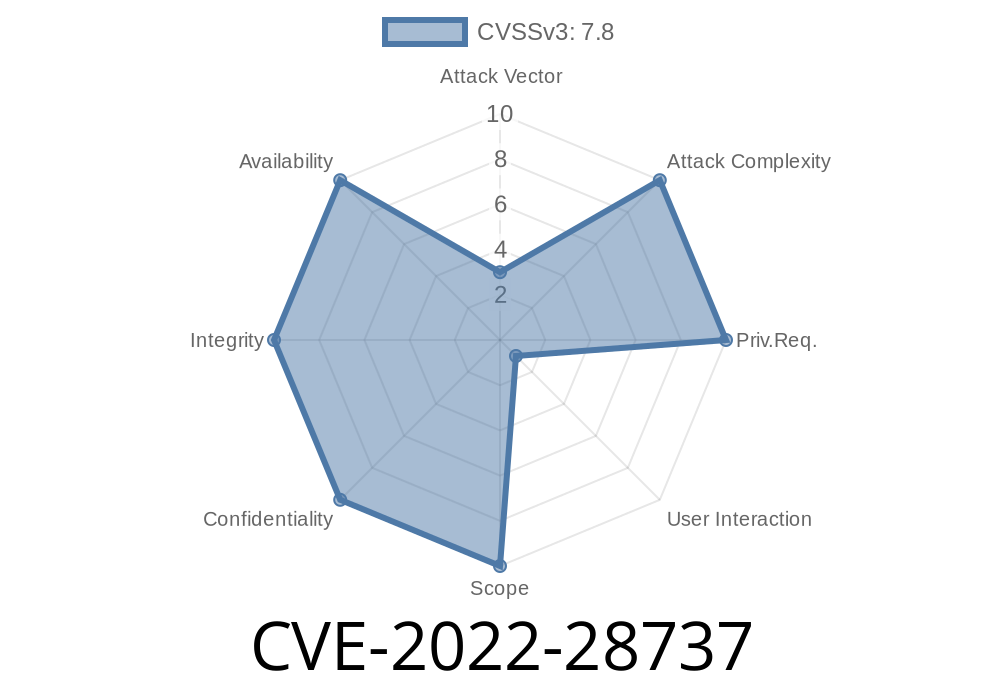A recent vulnerability has been identified in the handle_image() function of the shim, which is responsible for loading and executing crafted EFI executables. This vulnerability, dubbed CVE-2022-28737, could allow for potential out-of-bound memory writes leading to arbitrary code execution in specific scenarios. This blog post will delve into a detailed analysis of this vulnerability, including its root cause, code snippets, links to original references, and an overview of the potential exploitation process.
Root Cause
The core issue behind this vulnerability lies in how the handle_image() function processes the SizeOfRawData field from each section of the EFI executable to be loaded. It is possible for an attacker to manipulate this field to trigger out-of-bound memory writes, which can ultimately lead to arbitrary code execution.
Code Snippet
Let's take a closer look at the code snippet that highlights the vulnerable part of the handle_image() function:
UINTN
load_section(UINT8 *data, image_section_t sec, UINT8 *base)
{
UINT32 offset;
UINT8 *loadbase;
offset = sec->PointerToRawData;
loadbase = base + sec->VirtualAddress;
CopyMem(loadbase, data + offset, sec->SizeOfRawData);
return sec->Misc.VirtualSize;
}
In the code snippet above, the function load_section() takes in three arguments: data (an array of UINT8 elements that represent the EFI executable's data), sec (a pointer to an image_section_t structure that represents a section in the executable), and base (another UINT8 array representing the location in memory where the ELF executable should be loaded).
The function calculates the loadbase by adding the VirtualAddress field from the sec structure to the base. Then, it proceeds to copy the contents of the data + offset array (from 'data' and 'offset' provided by 'sec->PointerToRawData') into loadbase for a total of sec->SizeOfRawData bytes.
As you can see from the code snippet, there aren't any sufficient boundary checks in place, which might allow an attacker to exploit this function by carefully crafting an EFI executable with manipulated SizeOfRawData values.
Refer to the following links for more information about this vulnerability
1. Official CVE Database: https://cve.mitre.org/cgi-bin/cvename.cgi?name=CVE-2022-28737
2. Shim Project Repository: https://github.com/rhboot/shim
Exploit Details
By crafting an EFI executable with maliciously manipulated SizeOfRawData fields, an attacker can potentially trigger out-of-bound writes into memory during the loading process with the handle_image() function. This might lead to arbitrary code execution under certain circumstances.
Craft a malicious EFI executable with manipulated SizeOfRawData fields in its sections.
2. Load the malicious EFI executable using the handle_image() function, leading to out-of-bound memory writes.
3. Leverage the out-of-bound memory writes to execute arbitrary code in the context of the shim process.
Conclusion
CVE-2022-28737 presents a potential overflow vulnerability in the handle_image() function when handling crafted EFI executables. Although exploiting this issue to achieve arbitrary code execution might require a specific set of conditions to be met, it is still a significant concern because it highlights a crucial absence of boundary checks in the shim's codebase. Developers and security researchers should be aware of this vulnerability, devise proper mitigation strategies, and always practice secure coding guidelines to minimize the risk of future vulnerabilities in the ecosystem.
Timeline
Published on: 07/20/2023 01:15:00 UTC
Last modified on: 07/28/2023 15:33:00 UTC
